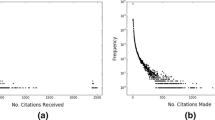Abstract
The study establishes three synthetic indicators derived from academic traces—assignee traces T 1, T 2 and ST—and investigates their application in evaluating technological performance of assignees. Patent data for the top 100 assignees in three fields, “Computer Hardware & Software”, “Motors, Engines & Parts”, and “Drugs & Medical”, were retrieved from USPTO for further analysis. The results reveal that traces are indeed valid and useful indicators for measuring technological performance and providing detailed technical information about assignees and the industry. In addition, we investigate the relationship between traces and three other indicators: patent citation counts, Current Impact Index and patent h-index. In comparison with the three other indicators, traces demonstrate unique advantages and can be a good complement to patent citation analysis.













Similar content being viewed by others
References
Banerjee, P., Gupta, B., & Garg, K. (2000). Patent statistics as indicators of competition an analysis of patenting in biotechnology. Scientometrics, 47(1), 95–116.
Breitzman, A., & Narin, F. (2001). U. S. Patent. US6175824.
Chang, K. C., Chen, D. Z., & Huang, M. H. (2012). The relationships between the patent performance and corporation performance. Journal of Informetrics, 6(1), 131–139.
Chen, D. Z., Lin, W. Y. C., & Huang, M. H. (2007). Using essential patent index and essential technological strength to evaluate industrial technological innovation competitiveness. Scientometrics, 71(1), 101–116.
Deng, Z., Lev, B., & Narin, F. (1999). Science and technology as predictors of stock performance. Financial Analysts Journal, 55(3), 20–32.
Griliches, Z., Pakes, A., & Hall, B. H. (1988). The value of patents as indicators of inventive activity. Cambridge, MA: National Bureau of Economic Research.
Guan, J. C., & Gao, X. (2009). Exploring the h-Index at patent level. Journal of the American Society for Information Science and Technology, 60(1), 35–40.
Hagedoorn, J., & Cloodt, M. (2003). Measuring innovative performance: Is there an advantage in using multiple indicators? Research Policy, 32(8), 1365–1379.
Hall, B. H., Jaffe, A. B., & Trajtenberg, M. (2000). Market value and patent citations: A first look (Working Paper No. 7741). National Bureau of Economic Research.
Hall, B. H., Jaffe, A. B., & Trajtenberg, M. (2001). The NBER patent citation data file: Lessons, insights and methodological tools (Working Paper No. 8498). National Bureau of Economic Research.
Hall, B. H., Jaffe, A., & Trajtenberg, M. (2005). Market value and patent citations. Rand Journal of Economics, 36(1), 16–38.
Harhoff, D., Narin, F., Scherer, F. M., & Vopel, K. (1999). Citation frequency and the value of patented inventions. The Review of Economics and Statistics, 81(3), 511–515.
Hirsch, J. E. (2005). An index to quantify an individual’s scientific research output. Proceedings of the National Academy of Sciences of the United States of America, 102(46), 16569–16572.
Hirschey, M., & Richardson, V. J. (2001). Valuation effects of patent quality: A comparison for Japanese and U.S. firms. Pacific-Basin Finance Journal, 9(1), 65–82.
Hirschey, M., Richardson, V. J., & Scholz, S. (2001). Value relevance of nonfinancial information: The case of patent data. Review of Quantitative Finance and Accounting, 17(3), 223–235.
Karki, M. (1997). Patent citation analysis: A policy analysis tool. World Patent Information, 19(4), 269–272.
Kuan, C. H., Huang, M. H., & Chen, D. Z. (2011a). Positioning research and innovation performance using shape centroids of h-core and h-tail. Journal of Informetrics, 5(4), 515–528.
Kuan, C. H., Huang, M. H., & Chen, D. Z. (2011b). Ranking patent assignee performance by h-index and shape descriptors. Journal of Informetrics, 5(2), 303–312.
Leydesdorff, L., & Bornmann, L. (2011). Integrated impact indicators compared with impact factors: An alternative research design with policy implications. Journal of the American Society for Information Science and Technology, 62(11), 2133–2146.
Meyer, M. (2000). What is special about patent citations? Differences between scientific and patent citations. Scientometrics, 49(1), 93–123.
Meyer, M., & Bhattacharya, S. (2004). Commonalities and differences between scholarly and technical collaboration—An exploration of co-invention and co-authorship analyses. Scientometrics, 61(3), 443–456.
Narin, F., Noma, E., & Perry, R. (1987). Patents as indicators of corporate technological strength. Research Policy, 16(2), 143–155.
Sapsalis, E., van Pottelsberghe de la Potterie, B., & Navon, R. (2006). Academic versus industry patenting: An in-depth analysis of what determines patent value. Research Policy, 35(10), 1631–1645.
Thomas, P. (2001). A relationship between technology indicators and stock market performance. Scientometrics, 51(1), 319–333.
Trajtenberg, M. (1990). A penny for your quotes: Patent citations and the value of innovations. The Rand Journal of Economics, 21(1), 172–187.
Tseng, F.-M., Hsieh, C.-H., Peng, Y.-N., & Chu, Y.-W. (2011). Using patent data to analyze trends and the technological strategies of the amorphous silicon thin-film solar cell industry. Technological Forecasting and Social Change, 78(2), 332–345.
Wang, S. J. (2007). Factors to evaluate a patent in addition to citations. Scientometrics, 71(3), 509–522.
Ye, F. Y., & Leydesdorff, L. (2014). The “Academic Trace” of the performance matrix: A mathematical synthesis of the h-index and the integrated impact indicator (I3). Journal of the Association for Information Science and Technology, 65(4), 742–750.
Ye, F. Y., & Rousseau, R. (2010). Probing the h-core: An investigation of the tail-core ratio for rank distributions. Scientometrics, 84(2), 431–439.
Zhang, C. T. (2009). The e-Index, complementing the h-Index for excess citations. PLoS ONE, 4(5), e5429.
Acknowledgments
The authors are grateful for financial support from NSFC Grant No. 71173187, and thank Ms. Huei-Ru Dong for data processing, and Ms. Wei-Tzu Huang for data collection.
Author information
Authors and Affiliations
Corresponding authors
Appendix
Rights and permissions
About this article
Cite this article
Huang, MH., Chen, DZ., Shen, D. et al. Measuring technological performance of assignees using trace metrics in three fields. Scientometrics 104, 61–86 (2015). https://doi.org/10.1007/s11192-015-1604-8
Received:
Published:
Issue Date:
DOI: https://doi.org/10.1007/s11192-015-1604-8




